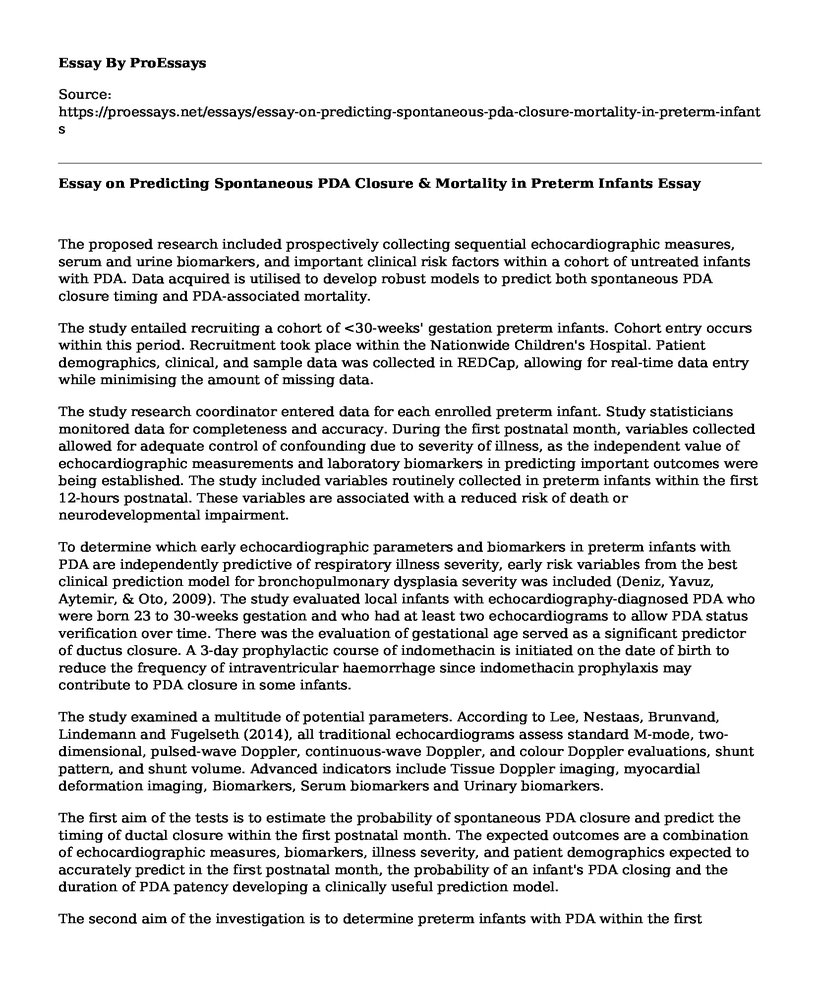The proposed research included prospectively collecting sequential echocardiographic measures, serum and urine biomarkers, and important clinical risk factors within a cohort of untreated infants with PDA. Data acquired is utilised to develop robust models to predict both spontaneous PDA closure timing and PDA-associated mortality.
The study entailed recruiting a cohort of <30-weeks' gestation preterm infants. Cohort entry occurs within this period. Recruitment took place within the Nationwide Children's Hospital. Patient demographics, clinical, and sample data was collected in REDCap, allowing for real-time data entry while minimising the amount of missing data.
The study research coordinator entered data for each enrolled preterm infant. Study statisticians monitored data for completeness and accuracy. During the first postnatal month, variables collected allowed for adequate control of confounding due to severity of illness, as the independent value of echocardiographic measurements and laboratory biomarkers in predicting important outcomes were being established. The study included variables routinely collected in preterm infants within the first 12-hours postnatal. These variables are associated with a reduced risk of death or neurodevelopmental impairment.
To determine which early echocardiographic parameters and biomarkers in preterm infants with PDA are independently predictive of respiratory illness severity, early risk variables from the best clinical prediction model for bronchopulmonary dysplasia severity was included (Deniz, Yavuz, Aytemir, & Oto, 2009). The study evaluated local infants with echocardiography-diagnosed PDA who were born 23 to 30-weeks gestation and who had at least two echocardiograms to allow PDA status verification over time. There was the evaluation of gestational age served as a significant predictor of ductus closure. A 3-day prophylactic course of indomethacin is initiated on the date of birth to reduce the frequency of intraventricular haemorrhage since indomethacin prophylaxis may contribute to PDA closure in some infants.
The study examined a multitude of potential parameters. According to Lee, Nestaas, Brunvand, Lindemann and Fugelseth (2014), all traditional echocardiograms assess standard M-mode, two-dimensional, pulsed-wave Doppler, continuous-wave Doppler, and colour Doppler evaluations, shunt pattern, and shunt volume. Advanced indicators include Tissue Doppler imaging, myocardial deformation imaging, Biomarkers, Serum biomarkers and Urinary biomarkers.
The first aim of the tests is to estimate the probability of spontaneous PDA closure and predict the timing of ductal closure within the first postnatal month. The expected outcomes are a combination of echocardiographic measures, biomarkers, illness severity, and patient demographics expected to accurately predict in the first postnatal month, the probability of an infant's PDA closing and the duration of PDA patency developing a clinically useful prediction model.
The second aim of the investigation is to determine preterm infants with PDA within the first postnatal month are predictive of mortality and severity of respiratory illness at 36-weeks postmenstrual age. The expected outcome includes accurately predicting the probability of mortality or requirement for supplemental oxygen or positive-pressure support at 36-weeks hence developing a clinically useful prediction model allowing for the estimation of the probability of mortality or moderate/severe CLD development.
The third of the investigation is to determine which echocardiographic predictors and biomarkers in preterm infants with PDA within the first postnatal month are associated with 22 to 26-month neurodevelopmental outcomes. The expected outcome is to accurately predict the probability of PDA-associated motor impairment at 22 to 26-months corrected age to create a useful prediction model that will allow estimation per week within the first postnatal month, the probability of PDA associated neurodevelopmental impairment at 22 to 26 months corrected age. The study used its final validated models to create a web-based tool that predicts an infant's unique probability of spontaneous PDA closure, mortality or 36-weeks PMA respiratory support requirement, and 2-year neurodevelopmental impairment.
The strengths of this investigation include a unique population of untreated infants with PDA and innovative modelling using advanced echocardiography, biomarkers, and clinical measures to accurately predict spontaneous PDA closure timing, and which infants with persistent PDA are at the highest risk for worsened PDA-associated outcomes. It will make significant contributions to scientific knowledge and effective PDA management. The study results will reduce overtreatment of infants with a high probability of early spontaneous PDA closure and facilitate development of outcomes-focused trials to examine the effectiveness of PDA closure in "high-risk" infants most likely to receive benefit.
References
Deniz, A., Yavuz, B., Aytemir, K., Hayran, M., Kose, S., Okutucu, S., ... & Oto, A. (2009). Intraleft atrial mechanical delay detected by tissue Doppler echocardiography can be a useful marker for paroxysmal atrial fibrillation. Echocardiography, 26(7), 779-784.
Jensen, E. A., Panitch, H., Feng, R., Moore, P. E., & Schmidt, B. (2016). Interobserver reliability of the respiratory physical examination in premature infants: a multicenter study. The Journal of pediatrics, 178, 87-92.
Jones, L. J., Craven, P. D., Attia, J., Thakkinstian, A., & Wright, I. (2011). Network meta-analysis of indomethacin versus ibuprofen versus placebo for PDA in preterm infants. Archives of Disease in Childhood-Fetal and Neonatal Edition, 96(1), F45-F52.
Lee, A., Nestaas, E., Liestol, K., Brunvand, L., Lindemann, R., & Fugelseth, D. (2014). Tissue Doppler imaging in very preterm infants during the first 24 h of life: an observational study. Archives of Disease in Childhood-Fetal and Neonatal Edition, 99(1), F64-F69.
Cite this page
Essay on Predicting Spontaneous PDA Closure & Mortality in Preterm Infants. (2023, Feb 11). Retrieved from https://proessays.net/essays/essay-on-predicting-spontaneous-pda-closure-mortality-in-preterm-infants
If you are the original author of this essay and no longer wish to have it published on the ProEssays website, please click below to request its removal:
- Asthma Self-Management
- Ethical Standards to Obtain Ethics Approval
- Essay Example: Patient Safety Risks
- Interview of Nurse Educator and Clinical Nurse Educator Paper Example
- Paper Example on Addressing Malnutrition to Improve Global Health
- Essay Example on Healthcare System: People, Organizations, Resources
- Essay Sample on Quit Smoking Now: Regain Your Health and Avoid Heart Disease Death







